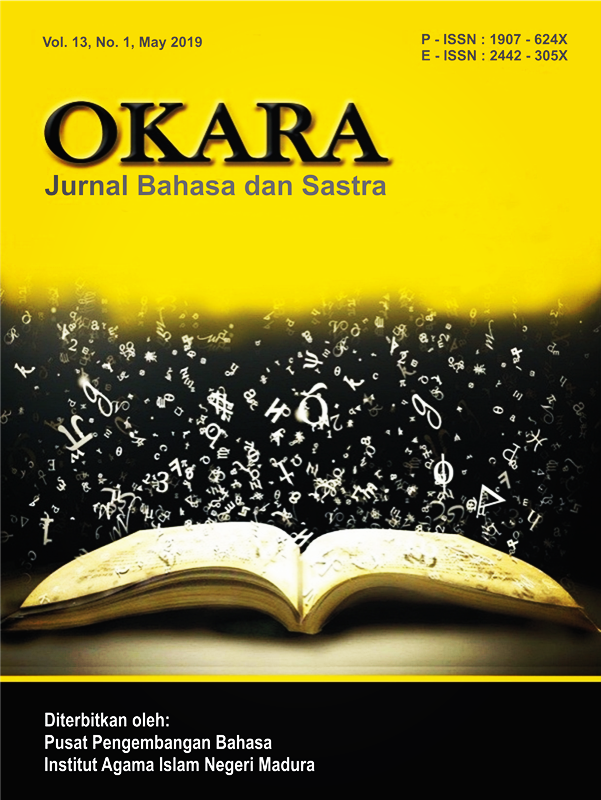Animal Metaphors in Iwan Fals’ Social Critics and Humanity Songs: Ecolinguistics Study
 Abstract views: 433
,
Abstract views: 433
,
 PDF downloads: 404
PDF downloads: 404
Abstract
Language and ecology have a reciprocal relationship in Ecolinguistics perspective. One of the relationships is formed through the metaphorical expression containing the names of fauna(animal metaphors). This study described the animal metaphors found in Iwan Fals’ Social Critics and Humanity songs that very famous among Indonesian community. Through Ecolinguistics study, the writer tried to find out how animal as a part of ecosystem can be used to describe human life especially their social and political life through metaphorical frames. This is a descriptive-qualitative research that is conducted by using Ecolinguistics parameters consists of interrelationship, diversity and environment parameters to analyze the interactions between language and ecology. The result of analysis showed that the metaphorical expression formulated and generated from the characteristic of the nature of fauna (animal metaphors) that found in Indonesian environment. The nature used as a source domain was mapped to a target domain referred to human beings with their activities forming a new understanding and enrich vocabulary. The connection between the two domains was recorded in cognitive of the language users at the ideological dimension which is then understood by society at the sociological dimension. The whole meaning formed a strong relationship between language and environment.
Downloads
References
Ardiel, Vonny. “Leksikon Dalam Tradisi Maambiak Ari Bacocok Tanam Padi Di Nagari Jaho Kabupaten Tanah Datar: Tinjauan Ekolinguistik.” Unpublished Thesis, Andalas University, 2017.
Asmanih. “Fakta Mengejutkan Di Balik Pemenuhan Kebutuhan Susu, Seekor Sapi Dipaksa Kawin Dan Hampir 150.000 Anak Sapi Terbunuh Tiap Tahun.” Erabaru (blog), December 28, 2017. http://m.erabaru.net/2017/12/28/fakta-mengejutkan-di-balik-pemenuhan-kebutuhan-susu-seekor-sapi-dipaksa-kawin-dan-hampir-150-000-anak-sapi-terbunuh-tiap-tahun/.
Badan Bahasa Depdiknas. Kamus Besar Bahasa Indonesia. 4th ed. Jakarta: Gramedia, 2014.
Batubara, Aron, Ronny Rachman Noor, Achmad Farajallah, and Bess Tiesnamurti. “Keragaman Genetik DNA Y-Kromosom Pada Enam Rumpun Kambing Lokal Indonesia.” In Seminar Nasional Teknologi Peternakan Dan Veteriner, 2013.
Budiman, Alvine. “Sistem Pakar Diagnosis Penyakit Akibat Gigitan Nyamuk Disertai Animasinya.” Unpublished Minithesis, Universitas Muhammadiyah Surakarta, 2014.
Bundsgaard, Jeppe, and Sune Steffensen. “The Dialectics of Ecological Morphology.” In Dialectical Ecolinguistics. Odense: Odense University, 2000.
Dastenaei, Mahnaz Talebi. “Ecometaphor: The Effect of Ecology and Environment on Shaping Anger Metaphors in Different Cultures.” The International Ecolinguistics Association Language & Ecology (2015): 18.
Døør, Jørge, and Jørgen Chr Bang. “Language, Ecology & Truth - Dialogue & Dialectics.” Sprogteori IX, 1995. http://www.jcbang.dk /main/ecolinguistics/Six.pdf.
Fals, Iwan. Sumbang. Mp3. Musica Studio, 1983.
Fill, Alwin, and Peter Mühlhäusler. Ecolinguistics Reader: Language, Ecology and Environment. London: Continuum, 2001.
Ghofur, Abd. “Reading Our Social Words: Utilizing Novels in Teaching Sociology Courses” 6, no. 1 (2012): 53–66.
Ghorbanpour, Amir. “Ecolyrics in Pop Music: A Review of Two Nature Songs.” The International Ecolinguistics Association Language & Ecology (2016): 10.
“Grasshopper - Facts, Diet & Habitat Information.” Accessed May 7, 2019. https://animalcorner.co.uk/animals/grasshopper/.
Hakim, Azizul, and Pratiwi Rimadani. “Uji Efektifitas Sampo Dari Minyak Mimba Sebagai Antikutu Di Rambut.” Farmaka 16, no. 1 (2018): 1–14.
Humairoh, St. “Otak Udang Dan Analogi Kebodohan.” KABAR KUSAM (blog), March 22, 2018. https://creativeliteraci.blogspot.com/2018/03/otak-udang-dan-analogi-kebodohan.html.
Idris, Muhammad. “Peternak Sapi Perah: Kalau Hitungan Akuntasi, Kami Rugi Terus Jual Susu.” Accessed May 6, 2019. https://finance.detik.com/berita-ekonomi-bisnis/d-3345969/peternak-sapi-perah-kalau-hitungan-akuntasi-kami-rugi-terus-jual-susu.
Kövecses, Zoltán. Metaphor in Culture: Universality and Variation. Cambridge: Cambridge University Press, 2005.
Lakoff, George, and Mark Johnsen. Metaphor We Live By. London: The University of Chicago Press, 2003.
Munawaroh, Siti. “Pekerja Seks Komersial (PSK) di Wilayah Prambanan, Kabupaten Klaten, Jawa Tengah.” Dimensia: Jurnal Kajian Sosiologi 4, no. 2 (2010): 69–82.
Pickrell, John. “Oldest Known Pet Cat? 9,500-Year-Old Burial Found on Cyprus,” April 8, 2004. https://www.nationalgeographic.com/animals/2004/04/oldest-known-pet-cat-9500-year-old-burial-found-on-cyprus/.
Sudaryanto. Metode Dan Aneka Teknik Analisis Bahasa: PengantarPenelitian Wahana Kebudayaan Secara Linguistis. Yogyakarta: Duta Wacana University Press, 2018.
Turiman, -. “Menelusuri ‘Jejak’ Lambang Negara Republik Indonesia berdasarkan Analisis Sejarah Hukum.” Jurnal Hukum & Pembangunan 44, no. 1 (February 26, 2014): 121–69. https://doi.org/10.21143/jhp.vol44.no1.18.
Wahyudi, M Zaid. “Tikus-tikus di Sekitar Kita Halaman all.” KOMPAS.com. Accessed May 7, 2019. https://regional.kompas.com/read/2013/04/04/04044145/tikus-tikus.di.sekitar.kita.
Wijaya, Surya Kusuma. “Masalah Infestasi Ektoparasit Pada Beberapa Jenis Burung Elang Di Habitat Eks-Situ.” Unpublished Minithesis, Institut Pertanian Bogor, 2008.
The journal operates an Open Access policy under a Creative Commons Attribution-NonCommercial 4.0 International License. Authors who publish with this journal agree to the following terms:
- Authors retain copyright and grant the journal right of first publication with the work simultaneously licensed under a Creative Commons Attribution License that allows others to share the work with an acknowledgement of the work's authorship and initial publication in this journal.
- Authors are able to enter into separate, additional contractual arrangements for the non-exclusive distribution of the journal's published version of the work (e.g., post it to an institutional repository or publish it in a book), with an acknowledgement of its initial publication in this journal.
- Authors are permitted and encouraged to post their work online (e.g., in institutional repositories or on their website) prior to and during the submission process, as it can lead to productive exchanges, as well as earlier and greater citation of published work.





_(1).png)
.png)
.png)
1.png)
.png)
.png)

.png)
_-_Copy_-_Copy.png)





